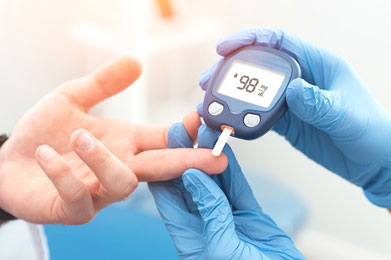Diabetes (Type 1 & 2)
Diabetes Mellitus is a group of metabolic diseases in which the body cannot regulate the amount of sugar (glucose) in the blood. People with diabetes either do not produce enough insulin (type 1 diabetes) or cannot use insulin properly (type 2 diabetes) or both (which occurs with several forms of diabetes).
There are two major types of diabetes. The causes and risk factors are different for each type:

Both type 1 and type 2 diabetes ultimately lead to high blood sugar levels, a condition called "Hyperglycemia". Over a long period of time, hyperglycemia damages the retina of the eye, the blood vessels of the kidneys, the nerves, and other blood vessels.
Currently available treatment (medicines, diet, insulin injection and exercise) can control blood sugar but cannot cure diabetes. Over the past several years, doctors have attempted to cure diabetes via transplanting functional insulin producing beta-islet cells and pancreas from donor. However, the requirement for steroid immunosuppressant therapy to prevent rejection of the pancreatic cells, increases the metabolic demand on insulin-producing cells and eventually they may exhaust their capacity to produce insulin and also shown deleterious effect on pancreas cell and shown less successful result.

Stem Cell therapy is another most effective treatment for diabetes mellitus because scientists have already proved that mesenchymal stem cells can be differentiates into pancreatic beta-islet cells after in-vitro culturing. Diabetes is metabolic and autoimmune disease means our body attacks to our own pancreatic cells as foreign cells so the treatment with autologous bone marrow derived mesenchymal stem cells (MSCs) provide immune-regulatory properties and stops the immune attack by secreting anti-inflammatory cytokines (IL-10, TGF-beta and IL-1). Stem cell treatment shows good improvement in diabetes patient because bone marrow derived stem cells concentrate (CD44+, CD31+, CD34+) has the capacity to regenerate the beta islets cells.
Stem cell can differentiate or regenerate into pancreatic beta-islet cells so produce more insulin. Stem cell therapy also differentiates into new vascularization so it provides good environment for beta islets cells regeneration. Stem cell provides immune-regulatory properties by secreting anti-inflammatory cytokines and stop inflammation into the pancreas cells.
Stem Cell Transplantation via catheter into the pancreatic artery:-
Patient with type-2 diabetes have both insulin resistance and insulin deficiency so stem cell can regenerate into functional beta islets.After stem cell migration (after getting chemical signal into the body) to the injured or dysfunctional area, it repair/regenerate that area so stem cell therapy reduces the resistance property of fat, liver and muscle for insulin.Stem cell therapy creates immune-regulatory property.
